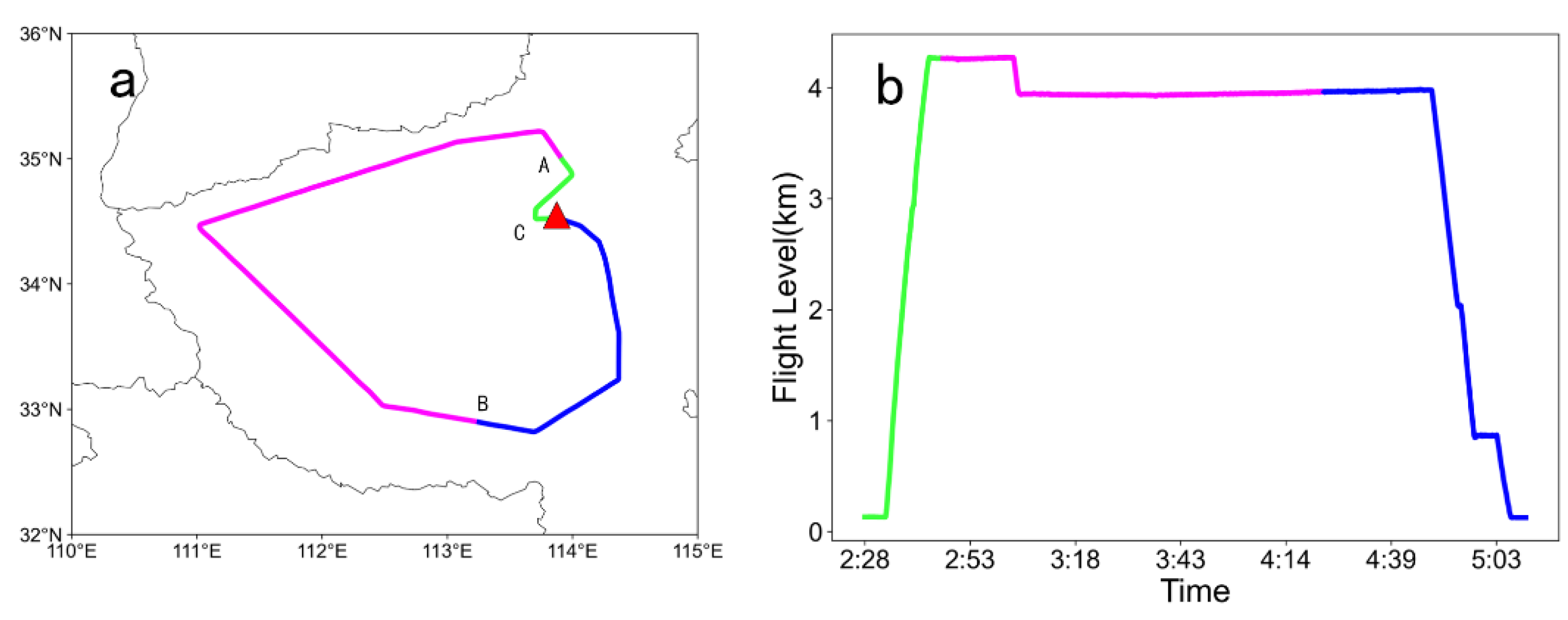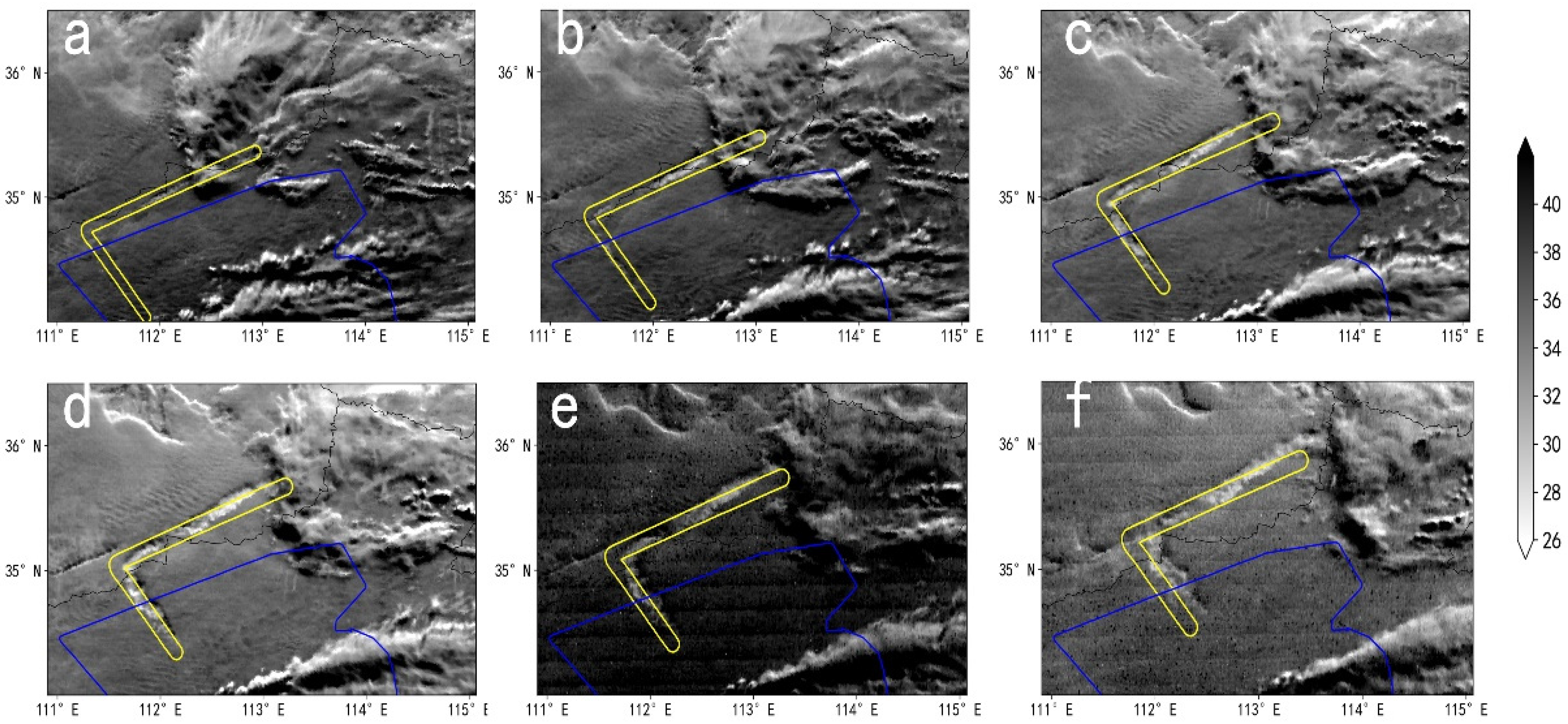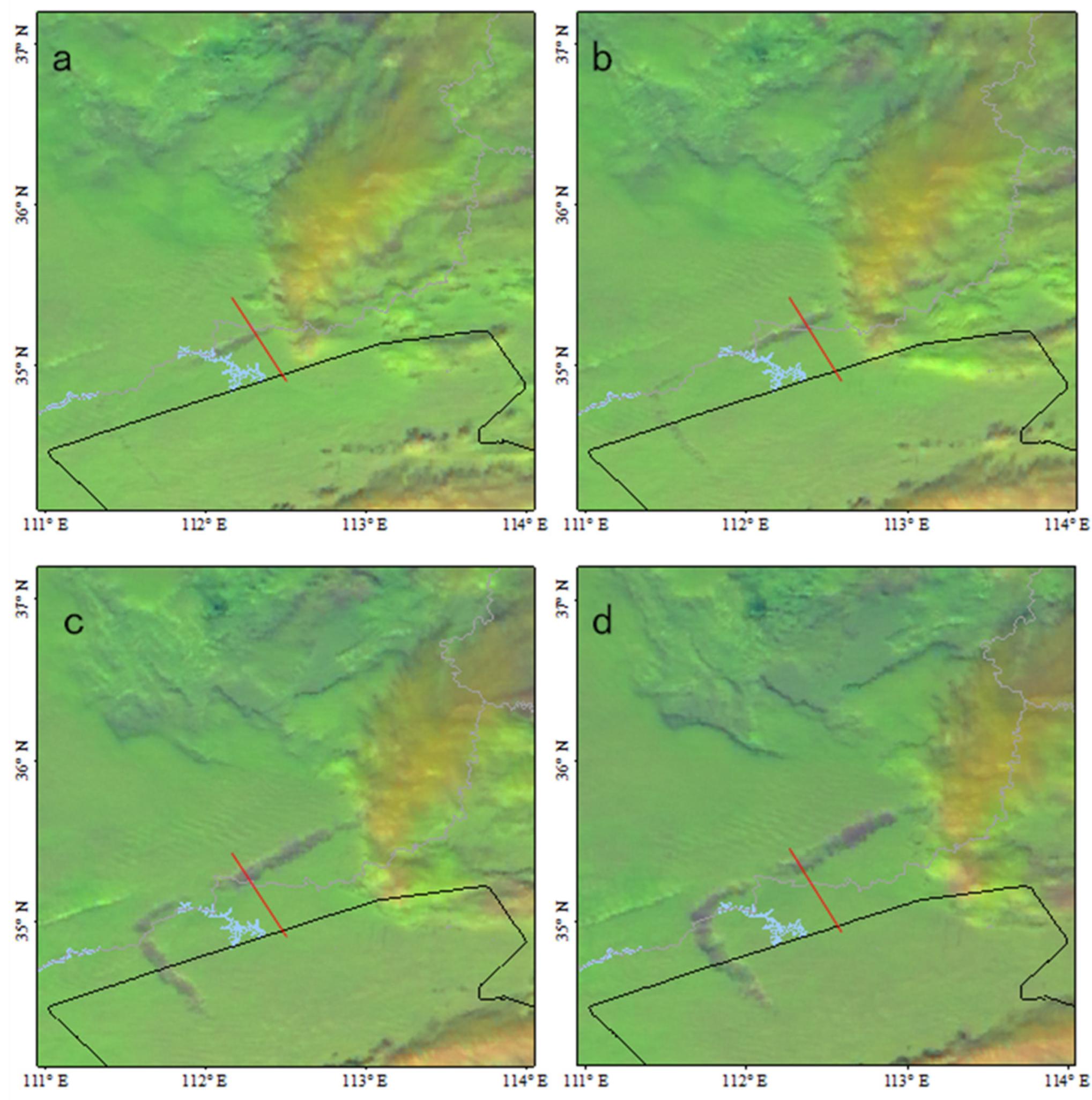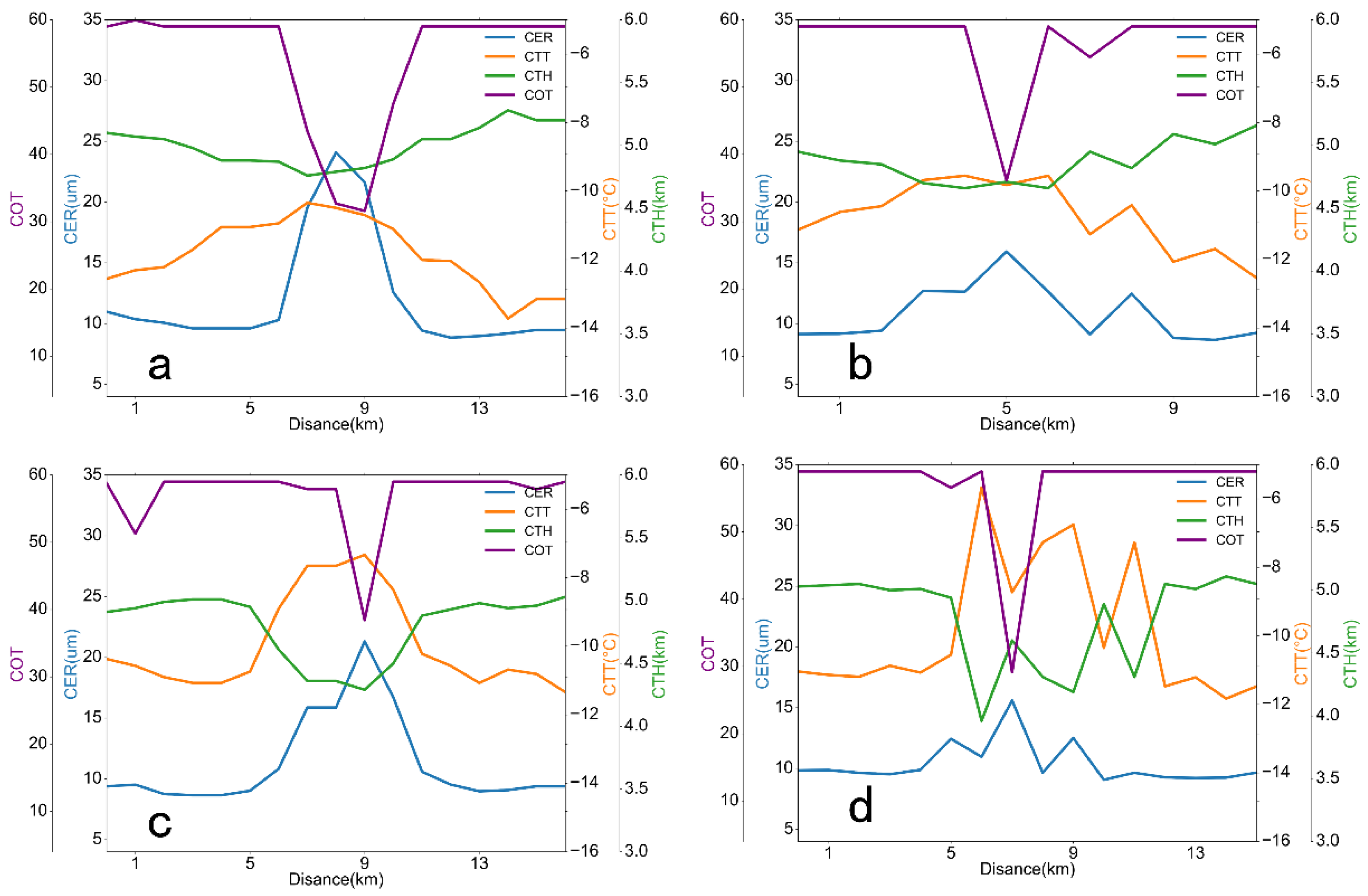FY-4A Measurement of Cloud-Seeding Effect and Validation of a Catalyst T&D Algorithm
Abstract
:1. Introduction
2. Overview of the Cloud-Seeding Operation and Data Processing
2.1. Flight Operations
2.2. Satellite Data, Products, and Processing
3. Satellite Identification of the Cloud Track and Its Evolutionary Characteristics
3.1. Structure of the Cloud System
3.2. Evolution of the Seeding Cloud Track
3.3. Comparison of the Cloud Track Observations of FY-4A and FY-3G
4. Calculation and Verification of Aircraft Catalyst Cloud-Seeding Particle Dispersion Transport
4.1. Aircraft Catalytic Dispersion Calculation Model
4.2. Verification of Catalyst Dispersion and Transmission Model
4.3. Quantitative Verification of Catalyst Dispersion Transmission width Calculation
5. Analysis of Microphysical Characteristics Inside and Outside the Cloud Track
6. Conclusions
- (1)
- The FY-4A’s and FY-3D’s 0.47 um and tri-channel-fusion cloud images show a cloud track produced by the aircraft catalyst seeding into cold clouds on 15 December 2019. This was the first time that a cloud-seeding cloud track was continuously (every 5–15 min) monitored by a geostationary satellite. The cloud track observed by FY-4A obtained a cloud track with a similar morphology and width to that of the high-resolution FY-3D measurements, although FY-3D can observe a finer cloud track structure.
- (2)
- Analysis of the continuous observation from the FY-4A cloud images showed that after 60 min of cloud seeding, the cold cloud precipitation process developed and consumed the supercooled cloud water, resulting in an obvious cloud track feature. The cloud track lasted for about 218 min, during which the cloud track moved in a northeastern direction for about 153 km, accompanied by the cloud system.
- (3)
- The aircraft catalyst T&D model developed by Zhou et al. [5] simulated the dispersion process of the aircraft cloud-seeding catalyst remarkably accurately as compared with the FY-4A cloud track observation. It was found that the position and width of the calculated AgI particle dispersion zone were consistent with the observed cloud track.
- (4)
- The FY-4A L2 cloud products exposed the microphysical characteristics of the cloud track. Inside the cloud track, the effective particle radius was significantly larger than that in the surrounding cloud region, and the maximum difference was about 15 μm. The cloud optical thickness of the cloud inside the cloud track was smaller than that in the surrounding cloud region, with a difference of about 30. The cloud-top height in the cloud track was about 0.3–1 km lower than that in the surrounding cloud region, and the corresponding cloud-top temperature was about 4.7 °C higher than that of the surrounding cloud. These results show that ice-phase particles were well developed in the cloud track due to the catalyst seeded by the aircraft, and some precipitation sedimentation occurred.
Author Contributions
Funding
Institutional Review Board Statement
Informed Consent Statement
Data Availability Statement
Acknowledgments
Conflicts of Interest
References
- Denni, A.S. Weather Modification by Cloud Seeding; Academic Press: New York, NY, USA, 1980; pp. 1–670. Available online: https://digitalcommons.usu.edu/water_rep/670/ (accessed on 18 February 1980).
- Dong, X.; Zhao, C.; Yang, Y.; Wang, Y.; Sun, Y.; Fan, R. Distinct change of supercooled liquid cloud properties by aerosols from an aircraft-based seeding experiment. Earth Space Sci. 2020, 7, e2020EA001196. [Google Scholar] [CrossRef]
- Shen, Y.; Chen, J. Stacking effect of catalysts sown by aircraft. J. Nanjing Meteorol. Inst. 1983, 2, 239–246. Available online: http://dqkxxb.ijournals.cn/dqkxxb/article/abstract/19830212?st=article_issue (accessed on 12 February 1983).
- Yu, X.; Fan, P.; Wang, X.; Dai, J.; Li, Z. Numerical simulation of catalyst dispersion from nonvertical multiple spreading line sources in stratiform clouds. J. Meteorol. 1998, 6, 69–84. Available online: https://qxxb.cmsjournal.net/cn/article/doi/10.11676/qxxb1998.065 (accessed on 7 March 1998).
- Zhou, Y.; Zhu, B. A study of catalytic dispersion patterns and operational design of artillery, rockets and aircraft. Meteorology 2014, 40, 965–980. Available online: http://qxqk.nmc.cn/html/2014/8/20140807.html (accessed on 7 August 2014).
- Woodley, W.; Rosenfeld, D.; Strautins, A. Identification of a seeding signature in Texas using multi spectral satellite imagery. J. Weather. Modif. 2000, 32, 37–52. [Google Scholar] [CrossRef]
- Yu, X.; Dai, J.; Rosenfeld, D.; Lei, H.; Xu, X.; Fan, P.; Chen, Z. Comparison of Model-Predicted Transport and Dispersion of Seeding Material with NOAA Satellite-Observed Seeding Track in Supercooled Layer Clouds. J. Appl. Meteorol. 2005, 44, 749–759. [Google Scholar] [CrossRef]
- Rosenfeld, D.; Yu, X.; Dai, J. Satellite-Retrieved Microstructure of AgI Seeding Tracks in Supercooled Layer Clouds. J. Appl. Meteorol. 2005, 44, 760–767. [Google Scholar] [CrossRef]
- Wang, J.; Yue, Z.; Rosenfeld, D.; Zhang, L.; Zhu, Y.; Dai, J.; Yu, X.; Liu, J. The evolution of an AgI cloud-seeding track in central China as seen by a combination of radar, satellite, and disdrometer observations. J. Geophys. Res. Atmos. 2021, 126, e2020JD033914. [Google Scholar] [CrossRef]
- Wang, T.; Luo, J.; Liang, J.; Wang, B.; Tian, W.; Chen, X. Comparisons of AGRI/ FY-4A cloud fraction and cloud top pressure with MODIS/ Terra measurements over East Asia. J. Meteorol. Res. 2019, 33, 705–719. [Google Scholar] [CrossRef]
- Yang, J.; Zhang, Z.; Wei, C.; Lu, F.; Guo, Q. Introducing the New Generation of Chinese Geostationary Weather Satellites, Fengyun-4. Bull. Am. Meteorol. Soc. 2017, 98, 1637–1658. [Google Scholar] [CrossRef]
- Chen, Y.; Chen, G.; Cui, C.; Zhang, A.; Wan, R.; Zhou, S.; Wang, D. Retrieval of the vertical evolution of the cloud effective radius from the Chinese FY-4 (Feng Yun 4) next-generation geostationary satellites. Atmos. Chem. Phys. 2020, 20, 1131–1145. [Google Scholar] [CrossRef]
- Chen, Y.; Li, W.; Chen, S.; Chen, S.; Zhang, A.; Fu, Y. Linkage between the vertical evolution of clouds and droplet growth modes as seen from FY-4A AGRI and GPM DPR. Geophys. Res. Lett. 2020, 47, e2020GL088312. [Google Scholar] [CrossRef]
- Yang, Z.; Zhang, P.; Gu, S.; Hu, X.; Tang, S.; Yang, L.; Xu, N.; Zhen, Z.; Wang, L.; Wu, Q.; et al. Capability of Fengyun-3D Satellite in Earth System Observation. J. Meteorol. Res. 2019, 33, 1113–1130. [Google Scholar] [CrossRef]
- Li, Q.; Sun, X.; Wang, X. Reliability Evaluation of the Joint Observation of Cloud Top Height by FY-4A and HIMAWARI-8. Remote Sens. 2021, 13, 3851. [Google Scholar] [CrossRef]
- Xu, W.; Lyu, D. Evaluation of Cloud Mask and Cloud Top Height from Fengyun-4A with MODIS Cloud Retrievals over the Tibetan Plateau. Remote Sens. 2021, 13, 1418. [Google Scholar] [CrossRef]
- Xu, N.; Niu, X.; Hu, X.; Wang, X.; Wu, R.; Chen, S.; Chen, L.; Sun, L.; Ding, L.; Yang, Z.; et al. Prelaunch Calibration and Radiometric Performance of the Advanced MERSI II on FengYun-3D. IEEE Trans. Geosci. Remote Sens. 2018, 56, 4866–4875. [Google Scholar] [CrossRef]
- Xu, J.; Liu, Z. Water vapour products from ERA5, MERSI-II/FY-3D, OLCI/Sentinel-3A, OLCI/Sentinel-3B, MODIS/Aqua and MODIS/Terra in Australia: A comparison against in situ GPS water vapour data. Q. J. R. Meteorol. Soc. 2023, 149, 1435–1458. [Google Scholar] [CrossRef]
- Wang, Y.; Li, G. Global Land Cover Mapping Using Annual Clear-sky Composites from FY3D/MERSI-II. Int. J. Remote Sens. 2022, 43, 510–531. [Google Scholar] [CrossRef]
- Zhang, Y.; Chen, Y.; Wang, M.; He, M.; Tan, J. FY-3D/MERSI-II Meteorological Satellite Image Fusion Method and its Application. In Proceedings of the IEEE 3rd International Conference on Information Systems and Computer Aided Education (ICISCAE), Dalian, China, 27–29 September 2020. [Google Scholar] [CrossRef]
- Xu, X.; Zeng, Y.; Yu, X.; Liu, G.; Yue, Z.; Dai, J.; Feng, Q.; Liu, P.; Wang, J.; Zhu, Y. Identification of Supercooled Cloud Water by FY-4A Satellite and Validation by CALIPSO and Airborne Detection. Remote Sens. 2023, 15, 126. [Google Scholar] [CrossRef]
- Zhou, Y.; Liu, S.; Cai, M.; Long, J.; Wang, J. Operational plan, effect verification, and key technical settings for a stadium-scale artificial rain reduction experiment. J. Meteorol. Res. 2023, 37, 643–665. [Google Scholar] [CrossRef]
- Sieglaff, J.M.; Cronce, L.M.; Feltz, F.W.; Bedka, K.M.; Pavolonis, M.J.; Heidinger, A.K. Nowcasting Convective Storm Initiation Using Satellite-Based Box-Averaged Cloud-Top Cooling and Cloud-Type Trends. J. Appl. Meteorol. Climatol. 2011, 50, 110–126. [Google Scholar] [CrossRef]
- Liu, G.; Yu, X.; Jia, L.; Dai, J. Satellite Retrieval of a Strong Hailstorm Process. Atmos. Ocean. Sci. Lett. 2009, 2, 103–107. [Google Scholar] [CrossRef]
- Rosenfeld, D.; Lensky, I.M. Satellite-based insights into precipitation formation processes in continental and maritime convective clouds. Bull. Am. Meteorol. Soc. 1998, 79, 2457–2476. [Google Scholar] [CrossRef]










| Time | 04:30 | 04:45 | 05:15 | 05:30 |
|---|---|---|---|---|
| Width of the FY-4A cloud track (km) | 3.36 | 6.96 | 12.53 | 14.93 |
| Width of the aircraft catalyst T&R model (km) | 10.19 | 9.60 | 12.81 | 14.20 |
| Profile | 1 | 2 | 3 | 4 |
|---|---|---|---|---|
| Width of the cloud track identified by the satellite (km) | 14.10 | 13.50 | 13.99 | 16.31 |
| Width of the aircraft catalyst T&D model result | 14.46 | 14.25 | 14.01 | 12.40 |
Disclaimer/Publisher’s Note: The statements, opinions and data contained in all publications are solely those of the individual author(s) and contributor(s) and not of MDPI and/or the editor(s). MDPI and/or the editor(s) disclaim responsibility for any injury to people or property resulting from any ideas, methods, instructions or products referred to in the content. |
© 2024 by the authors. Licensee MDPI, Basel, Switzerland. This article is an open access article distributed under the terms and conditions of the Creative Commons Attribution (CC BY) license (https://creativecommons.org/licenses/by/4.0/).
Share and Cite
Yan, L.; Zhou, Y.; Wu, Y.; Cai, M.; Peng, C.; Song, C.; Liu, S.; Liu, Y. FY-4A Measurement of Cloud-Seeding Effect and Validation of a Catalyst T&D Algorithm. Atmosphere 2024, 15, 556. https://doi.org/10.3390/atmos15050556
Yan L, Zhou Y, Wu Y, Cai M, Peng C, Song C, Liu S, Liu Y. FY-4A Measurement of Cloud-Seeding Effect and Validation of a Catalyst T&D Algorithm. Atmosphere. 2024; 15(5):556. https://doi.org/10.3390/atmos15050556
Chicago/Turabian StyleYan, Liangrui, Yuquan Zhou, Yixuan Wu, Miao Cai, Chong Peng, Can Song, Shuoyin Liu, and Yubao Liu. 2024. "FY-4A Measurement of Cloud-Seeding Effect and Validation of a Catalyst T&D Algorithm" Atmosphere 15, no. 5: 556. https://doi.org/10.3390/atmos15050556
APA StyleYan, L., Zhou, Y., Wu, Y., Cai, M., Peng, C., Song, C., Liu, S., & Liu, Y. (2024). FY-4A Measurement of Cloud-Seeding Effect and Validation of a Catalyst T&D Algorithm. Atmosphere, 15(5), 556. https://doi.org/10.3390/atmos15050556







